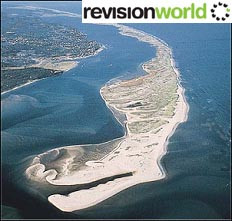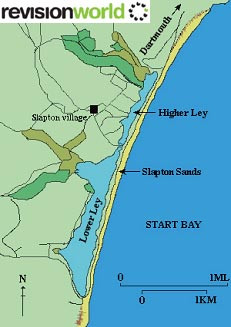Longshore Drift
When longshore drift transports material along the coast, it sometimes comes across an estuary or a change in the direction of the coastline.
In either case, the transport process tends to carry on moving the material in the same direction.
Over time, a ridge of material will build up into the deeper water.
This will form a spit.
Eventually the spit may form a substantial feature, many miles long with sand dunes and plants, possibly even buildings on it.
Many spits show a series of recurved ends which relate to material moved by winds creating waves from a different direction.

In the low-energy environment behind the spit, deposition of fine silt and mud will occur and salt marsh forms.
This helps to stabilise the landform.
Over time, spits may move inland and many are regularly broken by storms and reform in subsequent years.
If longshore drift carries material across a bay, it may form a bay barrier or bar.
Such bars rarely form across estuaries as the power of the river erodes material from the ends of the spit if the gap becomes very narrow. If longshore drift transports material across to a nearby island, then it forms a tombolo linking the island to the mainland.

Barrier islands are common depositional landforms along many coast such as the east coast of the USA.
They are created from a series of sandy islands totally detached from, but running parallel to, the mainland.
